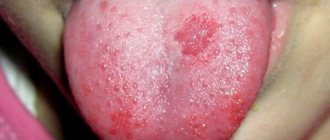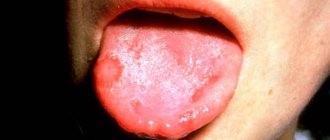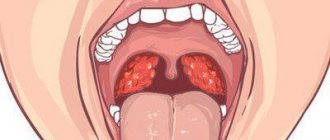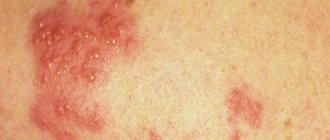Possible reasons
Stomatitis can lead to the appearance of ulcers on a child’s tongue.
The most common factors influencing the occurrence of ulcers on a child’s tongue include:
- development of candidiasis;
- presence of stomatitis;
- consequence of injury or thermal burn;
- the presence of diseases of the gastrointestinal tract;
- manifestation of the consequences of taking certain medications;
- the result of a weakened immune system.
The appearance of red ulcers may be a consequence of:
- development of glossitis;
- the presence of stomatitis;
- the occurrence of bacterial dermatosis;
- development of herpetic infection;
- allergic reaction.
The appearance of ulcers or white plaque may indicate the presence of:
- glossitis of non-infectious nature;
- hormonal imbalance;
- parasitic infection;
- dysfunction of the gastrointestinal tract.
Red sores on the tongue
Red sores have many variations in the nature of their occurrence. If there are red ulcers in the mouth, you should definitely check with the child whether they cause discomfort or hurt. If they cause a painful reaction, then their nature is most likely infectious.
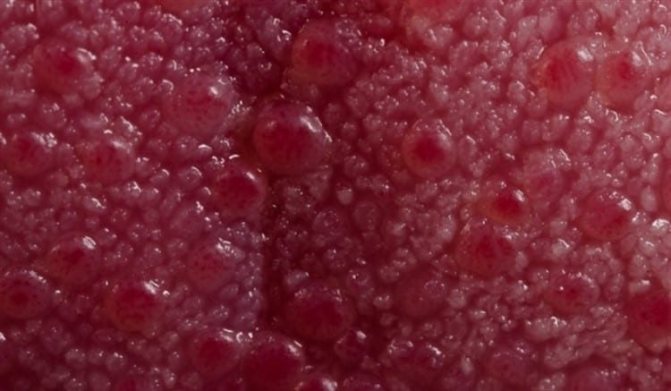
Red sores on a child's tongue
In this case, it is worth limiting the child’s access to objects with a questionable level of cleanliness, monitoring constant hand washing, and also treating all personal items: cutlery, pacifiers, etc. Also, poorly washed vegetables and fruits should not be allowed.
In addition, red sores may indicate the presence of diseases such as:
- stomatitis;
- glossitis;
- dysbacteriosis;
- viral diseases;
- disorders in the gastrointestinal tract.
The presence of ulcers of this type has a wide range of possible occurrences, so it would be a good idea to consult a doctor for detailed consultation and testing.
Characteristic manifestations
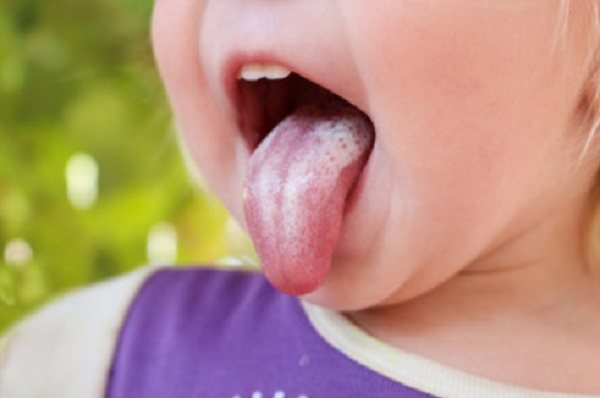
The appearance of ulcers on the tongue may be accompanied by a white coating
Based on what exactly led to the appearance of ulcers on the tongue, various accompanying symptoms may be noted.
- In the presence of aphthous stomatitis, ulcers with a diameter of up to five millimeters, pain, and possible bleeding are noted. Initially, there is redness on the tongue, which, without proper attention, turns into a white or gray ulcer. There may also be a white coating on the tongue.
- With herpes stomatitis, transparent or yellowish contents are noted in the blisters. After such a vesicle breaks through, gray-white ulcers with a thin scarlet rim are formed. There may also be elevated temperature and enlarged lymph nodes.
- With candidiasis (in common parlance, thrush), white ulcers are observed on the child’s tongue; they may also have a yellowish tint. Along the way, there is dryness in the mouth, swelling, a feeling of tight mucous membranes, cracks in the corners of the mouth, and there may also be hyperthermia. Typically, these sores have an unpleasant odor.
- An allergic reaction - red ulcers on the child’s tongue, which have blurred outlines, can merge over time, and swelling of the face and lips is also noted.
- Problems with the gastrointestinal tract are characterized by white sores, disruption of the microflora in the oral cavity, and discomfort when swallowing or chewing food. The ulcers are usually located in small clusters.
- With mechanical trauma to the tongue, the presence of painless ulcers of a red or pink hue is noted. If these ulcers become infected, suppuration begins, accompanied by pain and yellow discharge.
It is important to know what symptoms may indicate the presence of a particular disease.
- A high temperature indicates inflammation in the body. Characteristic for herpes, candidiasis, aphthous stomatitis, allergies.
- Under the tongue ulcers can occur due to candidiasis, injury, or the presence of somatic ailments.
- An ulcer formed on the tip of the tongue, usually as a result of mechanical damage.
- If there is a coating on the tongue, then the appearance of formations is a symptom of problems with the digestive system or candidiasis.
- The appearance of tiny sores on the lips and tongue can be a symptom of a viral infection, in particular herpes.
Symptoms of wounds and ulcers on a child’s tongue
The surface of a healthy tongue is distinguished by a pure pink color, uniform coloring, and the absence of spots. Inflammation of the oral cavity often leads to the appearance of ulcers on the mucous membranes and tongue. Spots, erosions, itching and burning also appear. Sometimes all these manifestations occur simultaneously, then the child feels pain and discomfort. Formations on the tongue can be numerous or single, large or small in size.
The color of ulcers on a child’s tongue is determined by the cause of its appearance. Localization - on the tip of the tongue or under it, on the mucous membrane of the gums, cheeks, lips, palate. The age of manifestation is also not limited: ulcers are observed both in infants and in children after 5 years.
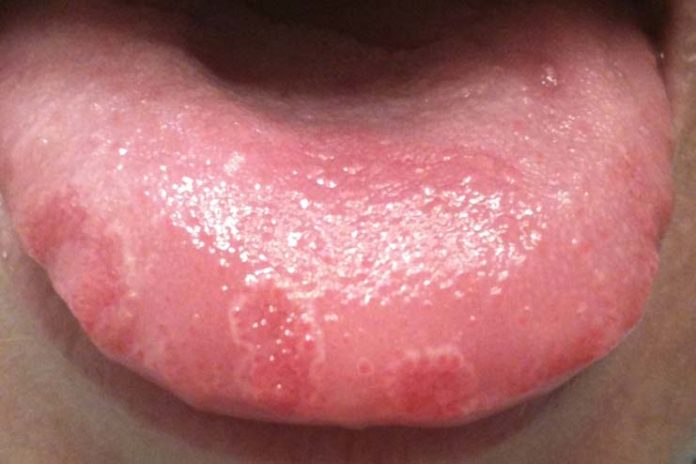
Diagnostics

The appearance of ulcers on a child’s tongue requires qualified diagnosis. Therefore, you should not delay visiting a doctor.
- The specialist will examine the child, ask questions and find out what accompanying symptoms are present and how long ago the ulcers appeared.
- The doctor will prescribe a certain examination:
- clinical analysis of urine and blood;
- biochemical blood test;
- determination of the bacterial composition of microflora in the oral cavity;
- cytological examination of plaque components to determine fungi of the genus Candida;
- immunological analysis to determine the performance of the body's protective functions.
Why might white blisters appear in a baby?
Most often, ulcers are caused by stomatitis. But other, more serious problems cannot be ruled out, which requires contacting a qualified specialist. Most often, the intestines and stomach are involved in the pathological process.
Sometimes the cause is infections caused by fungi, viruses, and bacteria. For example, herpes is characterized by red rashes and sores, they are accompanied by blisters, fever, and the appearance of an unpleasant odor. The bubbles gradually burst and dry out.
The appearance of sores can be caused by the following reasons:
- Decreased immunity.
- Carious lesions, pulpitis.
- Lack of vitamins. The mucous membrane of the tongue and lips is affected. The area around the lips and mouth is characterized by increased dryness.
- Mechanical injuries. The oral mucosa is very sensitive, and even minor damage can cause ulcers. Often the sores are caused by thermal burns. Sometimes a child causes wounds with his teeth, especially if he talks at the table.
In this case, the ulcers are localized at the tip of the tongue, under it. Even too rough use of a toothbrush causes pustules on a child’s tongue .
Larisa Kopylova
Dentist-therapist
Important! You cannot purchase and give vitamin complexes to children at will. Only the doctor can decide on this.
Stomatitis
This disease has a different nature and is provoked by infections, injuries, and internal factors. The sores are localized at the end of the tongue, gums, and palate mucosa. They are distinguished by a white or grayish tint, and in case of viral infection - light yellow.
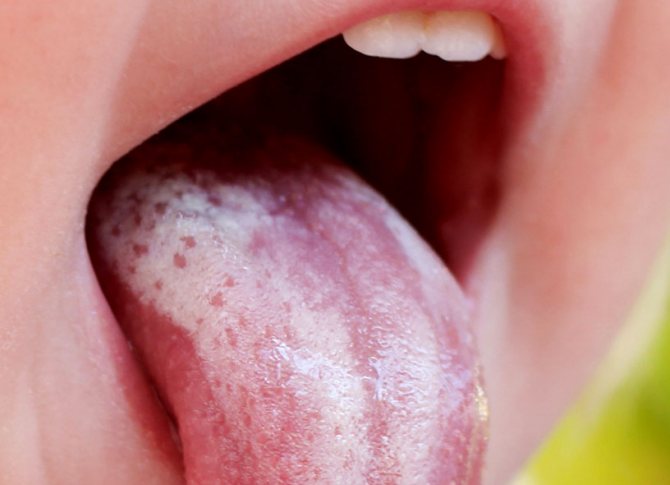
A whitish, cheesy coating indicates thrush. It is typical for children under one year of age. Predisposing factors include impaired immunity and antibiotic treatment. You cannot touch the white plaque or try to remove it yourself, this will injure the tissue.
Purulent sores on a child’s tongue with a characteristic odor are also a manifestation of stomatitis. Predisposing factors are insufficient hygiene and the entry of microbes into the mouth, since the child loves to put any objects in his mouth.
It is characterized by severe pain, the baby feels severe discomfort, and the general condition is also disturbed. Infections, reduced immunity, and disruption of the gastrointestinal tract are also considered possible factors causing stomatitis.
Aphthous stomatitis is characterized by ulcers (aphthae) due to stress, lack of minerals (iron, magnesium), and hereditary predisposition. They are very painful and heal leaving scars.
Classification of ulcers on a child’s tongue, causes and description:
| View | Cause and manifestations | Therapeutic measures |
| Red sores | Inflammatory disease, infections (glossitis, bacterial dermatoses), allergies. Pain, increased salivation, increased temperature. | Complex treatment with anti-inflammatory and local antiseptic drugs. For allergies, histamines are prescribed and the source of the allergy is eliminated. |
| White ulcers with plaque | Fungal infection due to low immunity, often after antibiotics. | If it reappears, drug treatment is required as prescribed by a pediatrician. |
| Red spots with a white coating around the edges | There is no inflammatory process, hormonal levels are changed, the activity of the stomach and intestines is disrupted. | Drug treatment is not required: taking vitamins, restorative measures, using antiseptics. |
| Purulent ulcers with redness around the edges | Decreased immunity, poor hygiene. Sometimes they appear due to burns. | Treatment with antiseptics. |
Larisa Kopylova
Dentist-therapist
Important! Another cause of ulcers is enteroviral vesicular stomatitis, which is popularly called “hand-foot-mouth”. Caused by the Coxsackie virus.
Injuries and mechanical damage to the tongue
During the period of teething, children often scratch their tongue with sharp teeth. When a malocclusion develops and caries appears, the tongue is injured and ulcers form. Such manifestations quickly disappear, usually on the second day.
Allergic reaction
When you are allergic to certain irritants, severe pain is felt, the amount of saliva increases, and the temperature rises. Itching and redness of the skin appears. White ulcers on a child’s tongue vary in size and location.
Gastrointestinal problems
If ulcers are observed in the oral cavity, they are also present on the intestinal walls, since dysbiosis often manifests itself as sores on the mucous membrane of the gums and tongue. Any diseases of the gastrointestinal tract cause a violation of the mineral balance, which ends in a change in the microflora of the oral mucosa. This leads to the formation of ulcers.
What could be the danger?

The appearance of ulcers on the tongue can pose a threat to the health of the child, regardless of whether the infection is fungal, bacterial or viral. It should be understood that the infectious process can spread beyond the tongue, which will cause even more health problems.
Lack of timely treatment of emerging ulcers can lead to:
- the addition of a secondary infection;
- the beginning of the development of a febrile state;
- spread of the inflammatory process to internal organs and facial skin;
- the appearance of colitis;
- liver dysfunction;
- manifestation of intoxication of the whole body;
- the occurrence of convulsive syndrome;
- damage to the nervous system;
- to the appearance of Quincke's edema, anaphylactic shock, if an allergic reaction occurs and contact with the allergen continues.
In a situation where the inflammatory process affects the disappearance of appetite and a decrease in the need for fluid, the child may develop exhaustion, as well as dehydration, which (especially in the youngest children) can lead to death.
When you need to see a doctor urgently

There are parents who, when the slightest health problem appears in their child, immediately run to consult a doctor. There are also those who will drag it out until the last minute. Therefore, it is important to know if any accompanying signs appear, in addition to the ulcers on the tongue themselves, you should immediately consult a doctor:
- the occurrence of skin rashes;
- temperature rise above 38 degrees;
- the appearance of bleeding from ulcers;
- the presence of severe pain;
- active growth of affected areas;
- swelling and hyperemia of the throat;
- severe weakness;
- increased anxiety;
- severe headaches;
- difficulty breathing.
Symptoms of the disease
It is simply impossible to miss all the signs of such an illness. As a rule, the child himself signals a problem. He screams and cries. In the baby's open mouth, you can notice rashes, a whitish or yellowish coating.
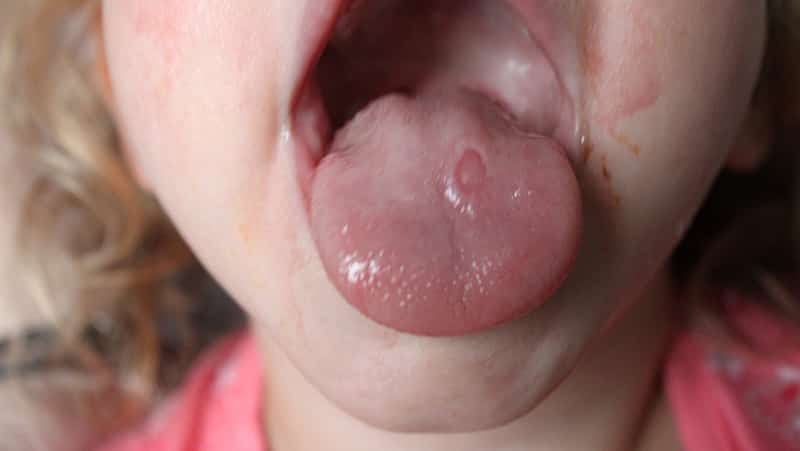
Sores on the tongue should not be ignored
Your child may refuse to eat. Red sores are often visible on the child's tongue. Photos in the gallery of our website illustrate these symptoms.
In such situations, most often the doctor speaks of stomatitis. In this case, a rash can appear not only on the tongue, but also on the palate, in the throat, on the inner surface of the cheek.
Treatment

Based on what exactly triggered the appearance of ulcers on the toddler’s tongue, further treatment will be determined.
- To reduce fever or relieve pain, Nurofen or Panadol may be prescribed.
- To relieve the inflammatory process - Tantum Verde spray or Cholisal gel.
- Kalgel is a local analgesic. It helps relieve pain directly at the site of the ulcer.
- Miramistin or Hexoral solution is used as an antiseptic for rinsing.
- Acyclovir is prescribed as an antiviral agent.
- If a remedy for allergies is needed, they can prescribe, for example, Suprastin.
- Immunomodulatory drugs, Viferon or Anaferon, are prescribed.
- If antibiotic therapy is necessary, they may prescribe, for example, Augmentin.
It is important to remember which drug is needed in your particular case, the doctor must determine it. It is also worth remembering that certain products are not allowed for the youngest.
Traditional methods

In certain cases, the use of traditional medicine is sufficient to normalize the child’s condition. However, you should not expect everything to go away on its own or self-medicate. It is better if you first consult a doctor. If the doctor considers it possible to use traditional medicine methods, he will prescribe folk remedies, calculating the dosage, taking into account the individual characteristics of your child.
- Honey. Suitable for a baby over one year of age if he is not allergic to this product. Liquid honey is applied to the sore, where it has an antiseptic effect. However, it is worth knowing that in certain diseases such a remedy can cause a worsening of the condition, so consulting a doctor is important.
- Cottage cheese containing lactic acid, which can act as an antiseptic, disinfects ulcers and heals them. Treatment in the use of this product by a child.
- Turmeric has anti-inflammatory, antiseptic and antibacterial effects. You can make a remedy using this product with the addition of honey. The resulting ointment is applied to the ulcer, which promotes both speedy healing and reduction of pain.
- Aloe vera. A paste is made from the leaves of this plant and applied to the sores.
- Coconut. Chilled coconut water is given to the child to drink. Or use pure coconut oil and apply it to the affected area.
- Rinsing the mouth with water and sea salt helps reduce pain.
Precautionary measures

Of course, there are no specific recommendations that will allow you to completely prevent your child from developing ulcers on his tongue. However, there are certain tips that you can follow to minimize the risk of their occurrence.
- Visit your dentist regularly, and see a specialist at least once every six months.
- It is important that the child monitors oral hygiene. If the baby is very small, then parents should deal with this issue.
- From an early age, it is worth teaching your baby to rinse the mouth after each meal in order to remove small particles.
- It is important to ensure that your baby has a complete diet, including all the necessary vitamins and minerals.
- Make sure that your little one is not overly stressed.
- If you know that your child is predisposed to allergic reactions, introduce allergenic foods into his diet with caution. Protect your baby from contact with substances that previously provoked an allergic reaction in him.
- Boost your baby's immunity. It is important to have healthy sleep, sufficient rest, and hardening.
Now you know what can provoke the appearance of ulcers on a toddler’s tongue. Remember that inaction regarding a problem that has arisen can worsen the baby’s well-being. Do not delay visiting the doctor; follow all his recommendations and prescriptions.


